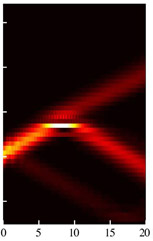Home > Press > Coupled particles cross energy wall: Model demonstrates that it is possible for two particles to cross an energy barrier together, where a single particle could not
 |
Abstract:
For the first time, a new kind of so-called Klein tunnelling—representing the quantum equivalent of crossing an energy wall— has been presented in a model of two interacting particles. This work by Stefano Longhi and Giuseppe Della Valle from the Institute of Photonics and Nanotechnology in Milan, Italy, is about to be published in EPJ B.
Coupled particles cross energy wall: Model demonstrates that it is possible for two particles to cross an energy barrier together, where a single particle could not
New York, NY and Heidelberg, Germany | Posted on May 30th, 2013Klein tunnelling is a quantum phenomenon referring to the fact that a high-potential barrier can be transparent to a particle moving at a speed nearing that of light, referred to as relativistic. Most of the previous Klein tunnelling models describe the phenomenon for a single particle. However, when two particles are involved, tunnelling can be modified as a result of their mutual interaction. This means, for example, that two electrons hopping on a lattice, or two ultra-cold atoms trapped in an optical lattice can exchange energy when they occupy the same lattice site.
The authors relied on an analytical and numerical study of a landmark model of interacting particles, called the Hubbard model. It is typically used to describe particle pairs in condensed matter such as in semi-conductors and in so-called matter wave physics, used for instance to describe microscopic particles oscillating between their material and wave-like characteristics. Longhi and Della Valle predict a new type of Klein tunnelling for a couple of interacting particles confronted by an energy barrier. Even though the barrier is impenetrable for single particles, it becomes transparent when the two particles cross the energy barrier together.
They expect these predictions to be confirmed experimentally in ultra-cold atoms trapped in optical lattices. If this is the case, similar quantum simulation could be a tool for emulating multiple-particle systems that cannot be modelled using classical computations.
####
For more information, please click here
Contacts:
Sophia Grein
49-622-148-78414
Copyright © Springer
If you have a comment, please Contact us.Issuers of news releases, not 7th Wave, Inc. or Nanotechnology Now, are solely responsible for the accuracy of the content.
| Related Links |
| Related News Press |
Physics
![]() Simulating magnetization in a Heisenberg quantum spin chain April 5th, 2024
Simulating magnetization in a Heisenberg quantum spin chain April 5th, 2024
News and information
![]() Simulating magnetization in a Heisenberg quantum spin chain April 5th, 2024
Simulating magnetization in a Heisenberg quantum spin chain April 5th, 2024
![]() NRL charters Navy’s quantum inertial navigation path to reduce drift April 5th, 2024
NRL charters Navy’s quantum inertial navigation path to reduce drift April 5th, 2024
![]() Discovery points path to flash-like memory for storing qubits: Rice find could hasten development of nonvolatile quantum memory April 5th, 2024
Discovery points path to flash-like memory for storing qubits: Rice find could hasten development of nonvolatile quantum memory April 5th, 2024
Discoveries
![]() Chemical reactions can scramble quantum information as well as black holes April 5th, 2024
Chemical reactions can scramble quantum information as well as black holes April 5th, 2024
![]() New micromaterial releases nanoparticles that selectively destroy cancer cells April 5th, 2024
New micromaterial releases nanoparticles that selectively destroy cancer cells April 5th, 2024
![]() Utilizing palladium for addressing contact issues of buried oxide thin film transistors April 5th, 2024
Utilizing palladium for addressing contact issues of buried oxide thin film transistors April 5th, 2024
Announcements
![]() NRL charters Navy’s quantum inertial navigation path to reduce drift April 5th, 2024
NRL charters Navy’s quantum inertial navigation path to reduce drift April 5th, 2024
![]() Discovery points path to flash-like memory for storing qubits: Rice find could hasten development of nonvolatile quantum memory April 5th, 2024
Discovery points path to flash-like memory for storing qubits: Rice find could hasten development of nonvolatile quantum memory April 5th, 2024
Interviews/Book Reviews/Essays/Reports/Podcasts/Journals/White papers/Posters
![]() Simulating magnetization in a Heisenberg quantum spin chain April 5th, 2024
Simulating magnetization in a Heisenberg quantum spin chain April 5th, 2024
![]() Discovery points path to flash-like memory for storing qubits: Rice find could hasten development of nonvolatile quantum memory April 5th, 2024
Discovery points path to flash-like memory for storing qubits: Rice find could hasten development of nonvolatile quantum memory April 5th, 2024
Quantum nanoscience
![]() Simulating magnetization in a Heisenberg quantum spin chain April 5th, 2024
Simulating magnetization in a Heisenberg quantum spin chain April 5th, 2024
![]() Optically trapped quantum droplets of light can bind together to form macroscopic complexes March 8th, 2024
Optically trapped quantum droplets of light can bind together to form macroscopic complexes March 8th, 2024
![]() Bridging light and electrons January 12th, 2024
Bridging light and electrons January 12th, 2024
![]() 'Sudden death' of quantum fluctuations defies current theories of superconductivity: Study challenges the conventional wisdom of superconducting quantum transitions January 12th, 2024
'Sudden death' of quantum fluctuations defies current theories of superconductivity: Study challenges the conventional wisdom of superconducting quantum transitions January 12th, 2024
|
|
||
|
|
||
| The latest news from around the world, FREE | ||
|
|
||
|
|
||
| Premium Products | ||
|
|
||
|
Only the news you want to read!
Learn More |
||
|
|
||
|
Full-service, expert consulting
Learn More |
||
|
|
||








